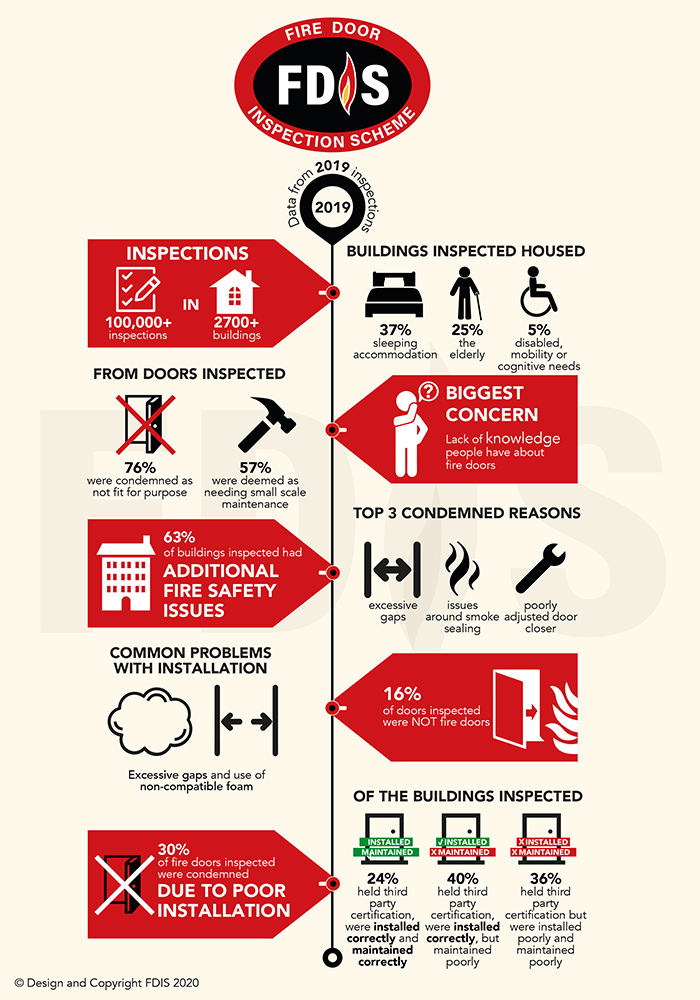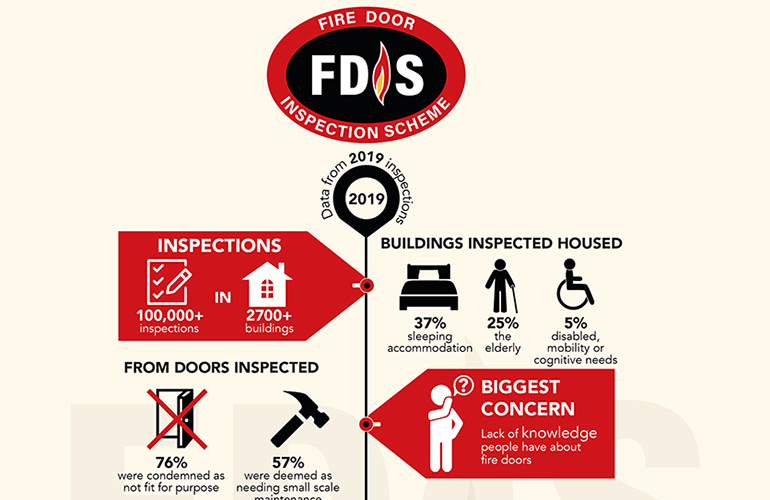In worrying news for the fire safety industry, the Fire Door Inspection Scheme (FDIS) has found that more than three quarters (76%) of fire doors it inspected in 2019 were condemned as not fit for purpose.
Further fire safety issues were also found in 63% of the buildings inspected by the FDIS.
The data, which refers to more than 100,000 inspections in over 2,700 buildings across the UK, also highlighted the challenges with fire door installation. 30% of fire doors nationwide were condemned due to poor installation, with problems including excessive gaps around the door and the use of non-compatible foam.

All FDIS inspectors follow a standard process and base their fire door assessments on an FDIS inspection checklist, where specific criteria have been set to ensure the doors are being inspected correctly. The specific criteria for the inspection are set by FDIS to ensure standards are being met and inspectors are following the same process. This enables the inspectors to generate an inspection report and note any non-compliant fire doors, highlighting the specific findings for each fire door inspected.
Louise Halton, Scheme Manager of FDIS, said: “The buildings that our inspectors visit include sleeping accommodation and those that house the elderly, the disabled, and people with mobility or cognitive needs – some of the most vulnerable in our society. However, the latest data shows that the vast majority of fire doors are not fit for purpose. This paints a very worrying picture of the fire safety of the UK’s buildings, and one that we must all play a role in changing for the better to help protect lives.”
Maintenance is clearly an issue within the industry, with 57% of fire doors inspected needing small scale maintenance. The top three reasons for failures were:
- Excessive gaps
- Smoke sealing issues
- Poorly adjusted door closers
Of the buildings inspected, nearly a quarter (24%) of fire doors that were third-party certificated were correctly installed and maintained, while 40% of third-party certificated fire doors were condemned due to poor maintenance and 36% due to both poor installation and poor maintenance.
The FDIS believe the frequency of fire door inspections should be based on a risk assessment approach as the required inspection frequency depends on many factors including the age of the door, the last time the door was inspected, and its current condition. It has been suggested that a minimum quarterly inspection rule may be applied when the new Fire Safety Bill is implemented, recommended in Phase One of the Grenfell Tower Inquiry.
Although quarterly inspections may be suitable for some fire doors, this wouldn’t be appropriate for high risk premises or high usage fire doors. Fire door inspections should be carried out by a suitably trained person. All approved FDIS inspectors are listed on the FDIS website.
Louise adds: “The biggest concern for our inspectors is the lack of knowledge that people have about fire doors. For example, third-party certificated fire doors provide crucial specification information and proof of performance for building owners, but if they are incorrectly installed or not maintained, they will not perform as designed and prevent the spread of fire.
“The correct specification, installation and ongoing maintenance of a fire door can really mean the difference between life or death for occupants, so it’s vital that building owners take responsibility and ensure that their fire doors are regularly inspected and maintained so as to save lives.”
Find out more information and download the FDIS data infographic, here.
2023 Fire Safety eBook – Grab your free copy!
Download the Fire Safety in 2023 eBook, keeping you up to date with the biggest news and prosecution stories from around the industry. Chapters include important updates such as the Fire Safety (England) Regulations 2022 and an overview of the new British Standard for the digital management of fire safety information.
Plus, we explore the growing risks of lithium-ion battery fires and hear from experts in disability evacuation and social housing.
